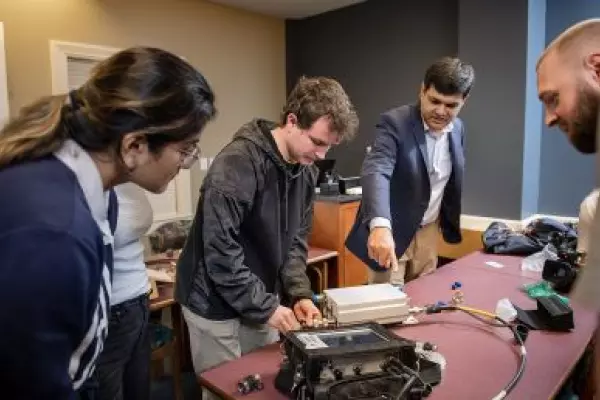
Successful launch paired with significant grant has AU ready to welcome next group into 5G program
ASHLAND, Ohio – Ashland University’s thriving 5G wireless technology workforce training program received a boost from the Ohio Department of Development on Aug. 10, when it was approved for a $250,000 grant through the Individual Microcredential Assistance Program. IMAP assists Ohioans who are low income, partially unemployed or totally unemployed participate in a training program to receive a credential at no cost.
Ashland, one of four training providers across the state to be awarded, will offer “any of our four 5G microcredentials to unemployed, under-employed and low-income Ohioans, free of charge,” confirmed Shawn Orr, dean of eAshland. “We have the ability to provide up to 150 microcredentials during this fall and spring, potentially making a significant impact on the Ohio broadband and 5G workforce.”
This marks the second offering of Ashland’s 5G training program, following a successful launch this past spring. The inaugural cohort took the State of Ohio’s 5G Readiness Pilot program, and 15 graduates completed it at Ashland, one of two institutions selected to participate (Youngstown State University was the other).
The first group featured a wide variety of backgrounds among the students, including a professional engineer with a master’s degree residing in the Cleveland area, a barber in Pennsylvania and undergraduate students and staff members at AU. But, no matter their background, they were all unanimous in their praise for the program’s mix of coursework and hands-on experience and now they are applying the knowledge they learned into the rapidly developing field of telecommunications.
Mayura Bhingarde, who works at Crown Castle, a communications infrastructure solutions company, wanted to learn about the “front (end) of networks, instead of just the back.” Taking the certification program already helped her shift from a fiber design engineer to a radio-frequency engineer position at her firm.
Stanton McKelvey, on the other hand, is utilizing the opportunity for a career change. A professional barber who learned about the program through a friend in Ashland, he plans to pursue a new path. “With the 5G readiness certificate, I plan on speaking with my instructors that led the class … (about) the opportunities. There are many available. I’m not sure which one I’ll be choosing, but I definitely plan on pursuing the direction of 5G wireless,” he said.
Jacob Owens and Katrina Rolince, both undergraduate students at AU, viewed the new program as a great opportunity to enhance their skill set. A senior computer science major, Owens is thankful to have added this “very particular credential” and noted the “fast-paced, up-to-date curriculum” will help anyone “upskill their degree.” He also feels that a “whole other world of leadership development” opened up for him, knowing this type of information will be crucial down the road for those in the computer science field who “work with the data sites (in) cellular tech.”
Rollince, also a computer science major, thought it was a no brainer “to jump at the opportunity” as well. Though a sophomore academically, she is confident she’ll be able to utilize the new knowledge she picked up “as a booster into a career in wireless or telecommunications” and “highly recommends the course for prospective students.”
The beauty of the program, according to Stephanie Donofe Meeks, director of workforce training and development at AU, is that 5G certification will be applicable to so many different career paths in the future. “5G has so many connections in so many different industries. Self-driving cars need really good connectivity and low latency between information transfers. Another example is the health care industry with the growth in televisits. Physician consults from across the country will require low latency. Everything that relies on WiFi, 5G broadband will make it more efficient,” she said.
Meeks noted that graduates will be prepared for “everything from cognitive jobs, such as a smart-grid analyst and health cloud analyst to skilled jobs, such as WiFi design engineer, telecom project manager and robotics-related positions.”
Eager to expand upon the diverse and successful inaugural group, Ashland is pleased to welcome a second class into the program this September.
For more information on the 5G training program, contact Meeks at smeeks2@ashland.edu or visit the AU workforce development webpage.